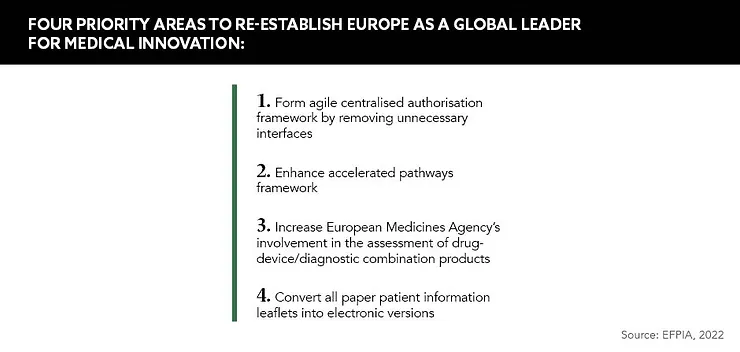Europe has been a key player in producing solutions to the pandemic, but there are issues that mean innovation more generally is being stifled. Which areas do industry experts think need most attention as reforms and policies are considered?
Words by Cheyenne Eugene
Europe has been a key innovation hub for generating remedies to the pandemic, but barriers exist within its overall innovation landscape that are causing the continent’s competitive position to fall short of its potential.
Although Europe is still a front runner for pharmaceutical research and thought leadership, this is not always translating into home-grown innovation, and industry leaders are keen for this to change for the better. “Europe is not just the place where we breed out all the good ideas, but where we can also capitalise on some of the value chains that should go with that,” says Stefan Oelrich, President, Pharmaceuticals Division, and member of the Board of Management, Bayer AG, speaking on FT Live’s webinar ‘Supporting Pharma Innovation in Europe’.
With the European Commission having established a new pharma strategy at the end of 2020, and a resulting proposal for the revision of pharmaceutical legislation now imminent, the topic of innovation is moving to centre stage, bolstered by the publication of EFPIA’s ‘Evidence MIX Report’ in January 2022. So, how can Europe ensure innovation continues to flourish once COVID-19 is no longer an active accelerator?
The valuing of innovation
When it comes to innovation in Europe, Bill Anderson, CEO, Roche Pharmaceuticals, says there are reasons for optimism and “the historical impact of Europe in life sciences… has been really strong”, although he acknowledges that there are complicating factors. One of the most significant issues raised by industry experts around the stifling of innovation is the need to create an enticing environment that pulls the interest of investors. Innovative companies tend to set up and invest in the places where that innovation is most valued and reimbursed.
Access to capital is the short answer from Anderson, who was also speaking on FT Live’s webinar. “I think there’s a danger that sometimes people overlook the obvious. They think of some sophisticated industrial strategy,” he explains. “The simplest answer is to make sure there’s a friendly reception for innovative new medicines when they arrive.”
Innovation does not always need to ‘arrive’, however. If the seeds are sown locally, Europe could yield the fruits of its own labour. Comparing Europe with another giant in the global pharma sphere, Anderson says: “China certainly represents a country of great strength when it comes to innovation. They have both a populace that is highly educated and anxious to invest lives and careers in science and technology.” It is tempting to think of investment as purely venture capital rounds and financial reimbursements, but investment in people should not be overlooked. Funding in health, employment and academia are the most important building blocks that lead to nations with blossoming, innovative industries. “Europe can’t be complacent here,” urges Anderson.
Collaboration creates access
The pandemic has demonstrated the value of innovation, but will European policymakers translate these key learnings into action? “Once the pandemic is over, there will be other political priorities that will kick into gear,” says Oelrich. There is a shared apprehension that things could return to business as usual and that Europe will have other priorities, not least, of course, supporting the recovery of its overstretched healthcare systems.
“The pandemic was a great example of what can be done when there’s a crisis,” elaborates Anderson. “Now, the question is: is speeding up innovative life-saving new cancer drugs to patients a crisis?” He advocates that the same sense of urgency should be applied to the kinds of innovation that address unmet needs. In the short term, developing these therapies can be costly, but Anderson argues that Europe’s willingness to fund therapies is key. “If you have a curative treatment for a serious medical condition, that treatment could lead not only to saving someone’s life, but also to the avoidance of millions of dollars of healthcare costs for a single patient,” he says.
While European governments are eager to collaborate on new medicine development strategies, some of these same countries have extremely arduous processes for reviewing and funding innovative medicines. “In the US, the review cycle from the time a medicine is filed to approval averages at about 250 days. In the EU, that’s about 400 days,” highlights Anderson. That hurdle also exists alongside additional proceedings that can add months or years.
However, a solution lies in the unprecedented cuts European approval agencies have made to their processes over the past two years. COVID-19 crisis measures have led to more efficient approval pathways that should be capitalised on as the pandemic grows more distant.
“Dialogue with policymakers has never been so intense and so constructive and productive as I’ve seen over the past 24 months,” states Oelrich. “When you speak to each other, and when you fight a common enemy, that builds trust and that builds a different level of communication.”
Ultimately, companies and industries will migrate to environments that are most favourable, and Anderson concludes that “Europeans should demand that innovation is happening on the continent”. Investment, collaboration and access are all elements that recently guided the world towards prosperity during severe hardship. With reforms on the horizon, the continent must keep capitalising on these values and foster an infrastructure for innovation that revitalises the outlook for patients and the industry in Europe.










